

Networks like MERLIN have not attained the ultimate in astronomical resolving power. Provided that suitable arrangements can be made for combining the signals, there is no limit on how far apart the individual telescopes can be placed. The greater the distance, the greater the resolving power.
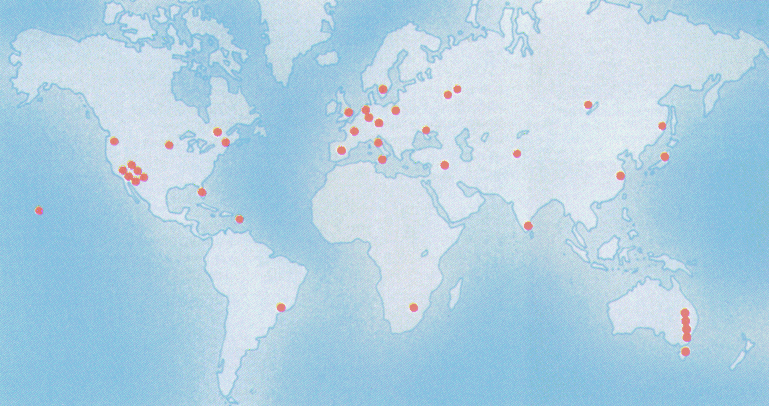
Observatories that have taken part in VLBI observations.
The technique for doing this is called VLBI, for Very Long Baseline Interferometry. It is especially suitable for occasional observations by large telescopes separated by hundreds or thousands of kilometres. VLBI differs from other kinds of interferometry in that the individual telescopes do not need to be connected in anyway. Instead,the radio signals are recorded at each telescope on high-capacity magnetic tape recorders, along with precise timing information from an atomic clock. The tapes are then sent to a correlating centre, where they are played together and combined just as if the signals were coming live from the telescopes. The correlated data can then be turned into images using similar software to that used by MERLIN.

Observatories of the European VLBI Network
Several observatories in Europe have come together to form EVN - the European VLBI Network - of which Jodrell Bank is a founder member. The correlating centre is at Max Planck Institute for Radio Astronomy in Bonn. The Lovell Telescope devotes 12 weeks a year to EVN observations, playing its part in the creation of a European supertelescope that stretches from Cheshire to the Crimea, and from Spain to Finland. Observing programmes are selected and coordinated by an international panel of astronomers. On occasion the whole of MERLIN is used as part of EVN, contributing many shorter baselines which help to produce a more complete image. The new 32-metre telescope is big enough to be an EVN station on its own right, filling the gap between Jodrell Bank and the nearest continental telescope at Westerbork in the Netherlands.
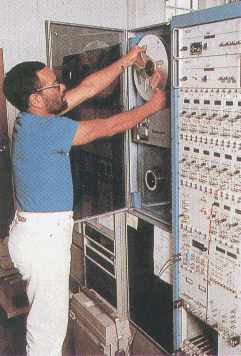 Changing a recording tape in the VLBI observing centre at Jodrell Bank. (Chris Johnson). |
On a still larger scale, observatories around the world routinely combine to form the World Array, a mega-telescope the size of the Earth. The logistics are formidable, but as many as 18 observatories have successfully worked together at the same time. Intercontinental VLBI is valuable not only to astronomers but also to geophysicists. By observing a well defined point source, such as a quasar, the positions of the telescopes can be computed to an accuracy of a few millimetres. In this way scientists have studied the steady drift of the continents and the slow wandering of the poles. |
But the Earth is not the limit of VLBI. For several years astronomers have worked on schemes to extend VLBI techniques out into space. Jodrell Bank is taking part in a project called IVS, the International VLBI Satellite, a plan to launch a large radio telescope into orbit around the Earth. In a highly elliptical orbit, the telescope will form a web of constantly changing baselines with observing stations on the ground.Astronomers will be able to synthesise an aperture many tens of thousands of kilometers in diameter, and probe deep into the hearts of even the most inscrutable galaxies and quasers.
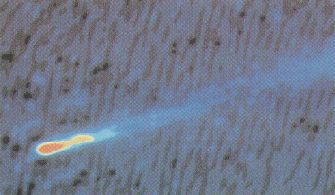
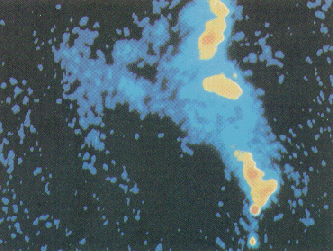 VLBI image of the complex jet in 3C48, the second quasar to be discovered. It was made with 17 telescopes in Europe, North America and the Soviet Union. The core of the quasar is at the bottom, and the jet has evidently been disrupted, possibly as a result of striking a dense gas cloud. |
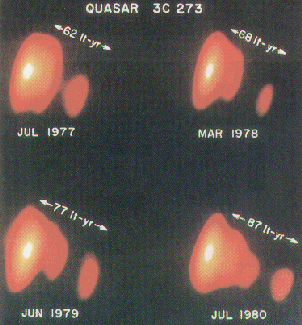 Successive VLBI images over three years of the core of the quasar 3C273, showing a cloud moving outward apparently faster than the speed of light. These "superluminal" motions are geometrical effects caused by the jet pointing almost directly towards us. (California Institute of Technology). |